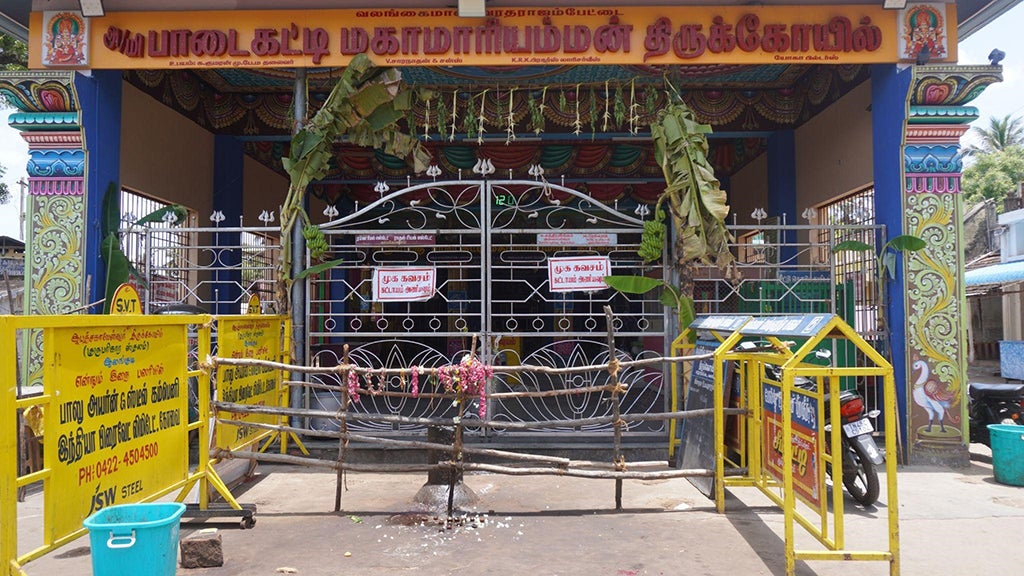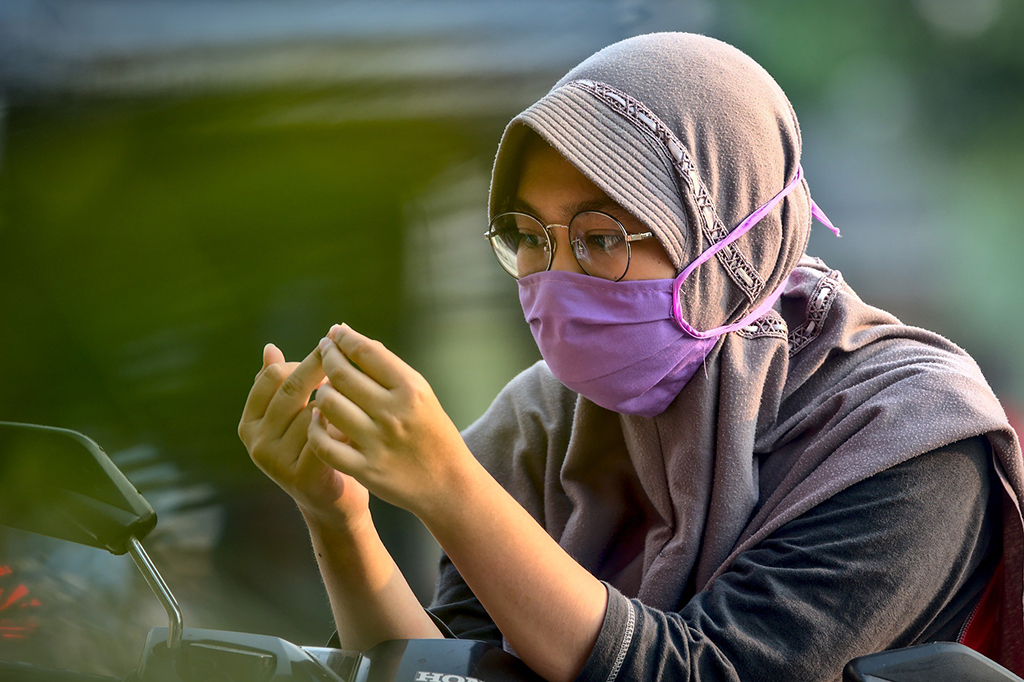Ambal is on Holiday
contributed by Sona Prabhakaran, 23 August 2021
While the pandemic as a ‘critical event’ (Das 1995) embodies some sense of universality as every nation witnessed a rupture in the spatio-temporal ordering of their reality, anthropologists are yet to fully understand the multiple renderings of these aberrations perceived by the interlocutors of their respective field sites. Through this piece, I shall attempt to briefly allude to how Goddess Mariamman and her divinity have been ascertained during a time when my field site, Valangaiman, has constantly been in a state of flux.
Guardian Deities as the Organising Principle
How one constructs narratives to make sense of the pandemic and its reverberations in the form of lockdown and state-imposed corporal restrictions has to be understood in conjunction with where they are emerging from and to what extent it has disrupted the organising principle of their everyday life.
Village gods and goddesses in Tamil Nadu often assume the role of guardian deities with the sole objective of protecting, ensuring fertility and prosperity to their devotees in a given village. Female deities, such as Goddess Mariamman, are widely feared for being the cause of death, destruction, and many heat-related epidemics such as smallpox, varicella, cholera, and measles.
Shingles and pustules that emerge on the bodies of afflicted persons are often seen as the physical manifestations of the goddess who has descended into their bodies, thereby making them deified entities. These devotees often resort to taking shelter in Mariamman temples to seek medication and cure for these epidemics and are therefore perceived as ‘celestial epidemiologists’ (Srinivas 2020).
Given that these goddesses are the cause and cure of diseases, many anthropologists (see for example Arumugam 2020a, b) were keen to understand if and to what extent their form and function would undergo a transformation with the onset of the pandemic. Would she now assume the role of Corona Mardini, the goddess who kills the Corona demon? How will she respond to state-imposed restrictions of her temple festivals and shut down her temples? Can she perform her duties if her divinity is constricted?
Situated amidst two branches of river Cauvery, Valangaiman is a Village Panchayat (council) in the Tiruvarur district of Tamil Nadu. Goddess Paadaikatiya Mariamman, also known as Ambal, is the epicenter of everyday life at this peri-urban village. She is widely known around the region for her ability to protect people from death. The annual temple festival celebrated in the month of Panguni (according to Tamil Calendar) that falls in the month of March observes a performative act of re-enacting funeral rituals to symbolize the exchange of lives between the goddess and her devotees. When discourses around the pandemic slowly garnered momentum in India’s public discourses (around the first week of March 2020), Valangaiman was engrossed in the arrangements of preparatory rituals for the temple festival.
During this time the inhabitants of my ethnographic field site viewed COVID-19 as a disease that only members of a certain ethnic group were susceptible to, namely, the Caucasians. The pandemic was viewed as retributive justice from the gods and goddesses for the former's transgressions in dietary practices. For two reasons, Valangaiman was convinced that their reality was immune to this novel virus.
- Firstly, their diet, which regularly includes the consumption of meat, is sanctioned by their guardian deities. Poultry farm birds and goats are regularly offered as Bali to these deities, which are later cooked within the temple premises and offered to them and devotees alike. This particular line of thinking—where the genealogy and the cause of COVID-19 was attributed to dietary practices of China—was extrapolated to the rest of the world. For instance, consumption of reptiles and insects are violations that no goddess could accept. Social media too provided a fertile ground to act as an echo chamber in broadcasting these narratives among my interlocutors. Furthermore, since the pandemic struck the subcontinent a little later, it validated all these claims and assured that the gods and goddess indeed favored India.
- Secondly, despite the increase in the number of COVID infected and death cases in India, Valangaiman was convinced that its quotidian life would remain unfazed since their guardian goddess Mariamman would act as the supreme protectress. As a goddess who protects people from death, my interlocutors were convinced that she would continue to do so without assuming a new role of Corona Mardini.
Nonetheless, as lockdown measures began to be implemented in phases (starting with the cancellation of the annual temple festival and all processional rituals associated with it, followed by a total shutdown of her temple), it was perceived as an act of aggression by the state rather than as a measure for safeguarding the citizens. Institutional interventions in the internal matters of the temple administration have always been a matter of contention in Tamil Nadu. Therefore, this particular exertion was viewed as a coup de main with the sole purpose of constricting the goddess. As a result, an incarcerated Ambal could no longer perform her duty as a guardian deity.

Figure 1: Paadaikatiya Mariamman Temple during the second lockdown, Valangaiman, May 2021. Credit: Author
 Figure 2: Goddess Padaikatiya Mariamman. Moments before she is taken out for processional ritual which is part of the annual temple festival. Valangaiman, April 2021. Credit: Author
Figure 2: Goddess Padaikatiya Mariamman. Moments before she is taken out for processional ritual which is part of the annual temple festival. Valangaiman, April 2021. Credit: Author
A Manufactured Hiatus and an Interlude for the Goddess
Having had the opportunity to revisit my field a year later (March-May 2021), it was interesting to observe a shift in the subject position of the goddess. She was no longer a ‘celestial epidemiologist’ for COVID-19. The pandemic, for the majority of my interlocutors, was a human-made disaster created in a laboratory in China. This crisis was neither perceived as a retributive justice from the gods, nor was it associated with other heat-epidemics. Since the virus was not the creation of the goddess (like other aforementioned heat epidemics), people infected with COVID-19 were not seen as deified entities. If the goddess was indeed the cause for the pandemic, then the afflicted individuals would be treated within the temple premises, just like smallpox, varicella, and measles.
The sheer cataclysmic loss that India was undergoing was perceived as a result of profit-mongering state and pharmaceutical companies. Hence, the goddess was neither responsible for the furor caused by the virus nor could one expect her to protect the devotees.
“One cannot drag the goddess into utter chaos caused by political parties and English medicine. To do so is equal to abdicating responsibility and letting the real culprits walk away. The past year people have died not because of the virus, but due to state induced poverty, distress, and atrocities during the nation-wide lockdown.”, remarked Vanita who have been performing fertility rituals for the past three years at the temple for women who are unable to conceive a child.
Vanita and others in Valangaiman who are predominantly categorized under OBC (Other Backward Castes) and were pushed to the brink of poverty during the lockdown believe that the novel Coronavirus does not exist. Instead, it was and still is a fabricated lie constructed by the state and ‘English medicine’ with the sole purpose of generating profit. CoronAsur, in the case of Valangaiman, is the state, Western medicine, and pharmaceutical companies that have conspired to unleash this havoc.
That being the case, what has Ambal been doing for the past year and a half?
“She is on a Holiday. But with a mask on her face.”
People of Valangaiman ascertain that the temple doors have never been shut down in the last two hundred years. This particular anomaly has not only induced this rupture but has also resulted in the waning of her divinity as it is directly proportional to the number of devotees paying their oblations to her. The annual temple festival additionally helps in increasing her divine powers in order to carry out her guardian duties.
The year 2020 witnessed her temple being shut down for the devotees for an extended period of six months accompanied by restrictions placed on her physical movements (as all forms of processional rituals were prohibited). This has gravely hindered the ‘breath of the goddess’ whereby she is forced to breathe ‘old and toxic air,’ and thus being suffocated to a point where she feels weak and nauseous, an experience shared by the inhabitants too when forced to wear surgical mask. The lockdown restrictions were perceived as symbolic masks that have been imposed on the goddess by the state. Given her diminishing powers, my interlocutors claimed that the goddess needs to conserve what remains of her divinity and is, therefore, on holiday. With no devotees around, she can finally unburden herself from the duties of a guardian deity and take some time off for herself.
Reference:
Das, Veena. 1995. Critical Events: An anthropological Perspective on Contemporary India. Vol. 7. New Delhi: Oxford University Press.
Disclaimer: The views and opinions expressed in this article are those of the authors and do not necessarily reflect the position of the blog editorial team or the Asia Research Institute.
South Asia | Southeast Asia | East Asia | Other Places | Hinduism | Buddhism | Islam | Christianity | Other Religions
Sona Prabhakaran is a doctoral candidate and a DAAD fellow at the South Asia Institute, University of Heidelberg in Germany. Her PhD thesis, tentatively titled "Funeral for the Living: The Ontology for Goddess Paadaikatiya Mariamman", is an ethnographic project that aims to explore how sacred spaces are produced and transformed in vernacular forms of religiosities that actively bring funeral rituals and signifiers of death into the temple premises as apart of an annual temple festival for Goddess Mariamman.
She can be contacted at: sona.prabhakaran@sai.uni-heidelberg.de
Other Interesting Topics
From Field to Digital Ethnography: Observing Ritual Transformations in Singapore’s Historic Places of Worship
2020 was supposed to be a year packed with fieldwork for me. I have just completed conducting a season of Bicentennial Walking Workshops on historic places of worship and have spent the last quarter of 2019 establishing contacts with 11 kinship-based clan associations that are over 100-years-old to document their intangible cultural...
Panchagavya, Gaumutra and Yoga: Re-inventing Hinduised Medical Practices in Times of Pandemic
The coronavirus has created a global crisis to which scientists have yet to give any decisive answer. Confronted with this huge danger, people are resorting to the repertoire of religion to cope with their anxiety and seek a meaning for the novel phenomenon, as well as...
Re-envisioning the Ummah in the ‘New Normal’
The emergence of the COVID-19 pandemic has undeniably been a watershed event in the 21st century. Much has been said about the various impacts of the pandemic, including the ways in which we organise and govern societies. These include forming new societal practices of safe distancing or the wearing of masks in public to ensure public health and safety...




